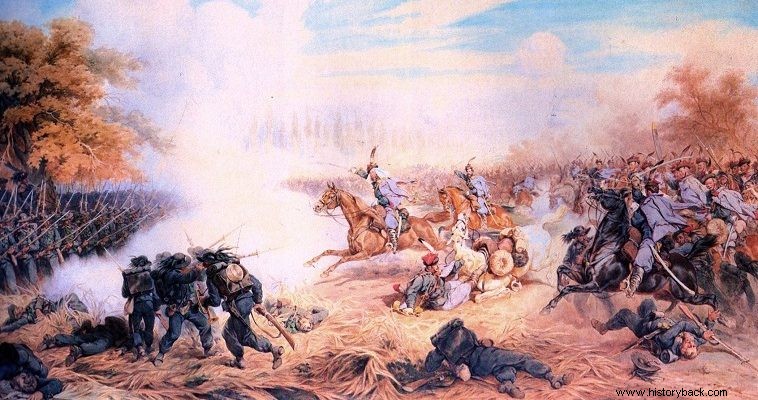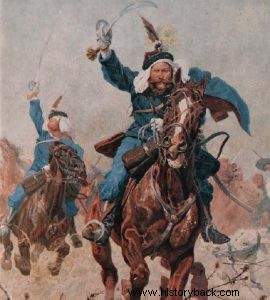
The Austro-Prussian War of 1866, also known as the Seven Weeks War, was decided on the Bohemian front by the overwhelming victory of the Prussians at the Battle of Sandova. However, large-scale operations were also conducted in Italy, between Prussia's Italian and Austrian allies. The conflict on this front was decided in the great battle of encounters, east of the river Mincio, which received its name from the small village of Koustoza.
The Austrians had 75,000 men (Southern Army under the excellent general, Archduke Albrecht of Habsburg) against 220,000 Italians (not all were involved). The Italian 1st Army under La Marmora had 120,000 men, while the 2nd, under General Cialdini, had 80,000 men. An independent Army Corps (SS) was also available. The battle began with the Italians' attempt to expand north of the Minzio River. After a particularly confused conflict, la Marmora was trying to strengthen his center against the Austrians, in the southeast, between Somacabana and Villafranca.
Colonel Pultz's Austrian Cavalry Division (MI) had been deployed there. The division made up of them had only 15 iles of light cavalry, hussars and ulanas (spearmen). Poultz's MI was primarily tasked with controlling the movements of the Italian 3rd SS, the first two Infantry Divisions (IP) of which, Prince Umberto's and Major General Bixio's, were reaching Villafranca. These two Italian MPs were reinforced by the MI of the 3rd SS, under Lt. Gen. Sonaz, with a force of 20 men. The Italian cavalry lined up to the right of the two MPs, as a flank guard.
It was 7:00 a.m. when Colonel Józef Rodakowski, a Polish-born officer in the Austrian Army, put himself in charge of four hulans and prepared to attack his Italian opponents. Pultz had been ordered by Albrecht to observe the opposing corps and not, of course, to charge against it with 15 horse of light cavalry.
Rodakowski, with a genuine Polish spirit, however, had a different perception. Indeed, when Albrecht's messenger arrived at Pulz's headquarters, conveying the commander-in-chief's order that the cavalry should not, under any circumstances, engage in a fight with the Italians, Rodakowski and his men, it was too late to recall. And as if that wasn't enough, seven more Austrian islands followed the hot-blooded Pole and his Ulans. Albrecht's staff messenger, seeing the troops advancing, told Pultz that a 12-mile attack against two Italian divisions and 20 miles of cavalry was tantamount to suicide. Pultz replied that Rodakowski would limit himself to a demonstration aimed at scaring the Italians.
But soon he heard gunfire. He then considered that the Italians were marching towards Somakabana, with the aim of threatening the left of the Austrian formation, and he himself, with the three remaining islands, moved in the direction of the enemy. Thus the 15 Austrian islands found themselves, in three echelons of four, seven and three islands, respectively, charging against two entire enemy divisions and 20 islands of Italian dragoons and cuirassiers. Rodakowski and his men, belonging to the 13th Uhlan Regiment, although outnumbered by 500, moved swiftly through the gap between the two Italian MPs and attacked the left flank of Prince Umberto's MP.
The Italian prince ordered his infantry to form squares, which they did, repulsing the gallant Uhlans with fire. The Ulans received the fire of thousands of Italian infantry. About 260 were killed in this desperate attack. The seven hussar islands that followed had a similar fate. Nevertheless the Austrian cavalry continued their attack, passed behind the Italian blocks and attacked the following Italian 3rd SS supply convoys, causing incredible confusion and panic. Frightened, the Italian drivers of the logistics wagons turned en masse back towards the river bridges they had crossed, preventing the following combat units from crossing, but also preventing the logistics units of the fighting, Vilafranca, divisions from crossing as well .
The panic spread to the headquarters of the 3rd SS commander, de la Rocca, 10 km behind Villafranca. The cries of "the Germans are coming." We are lost. May he who saves himself be saved!", could be heard everywhere. Several Italians who had not yet even encountered Austrians threw down their weapons and fled in disorder, crossing the river by all means, those on the east bank, or simply pushing west or south, those on the west bank. In this incredible confusion no order could reach the formations of the 3rd SS which had crossed the river and had, in effect, repulsed the desperate advance of the Austrian cavalry. The panic lasted several hours and immobilized the Italian 3rd SS, the strongest that the 1st Army had.
The heroic attack by Pulz's gallant light cavalry, which became known as the Austrian Light Brigade's advance, bought Albrecht valuable time, with the cooperation of the frightened Italians, of course, whose stronger SS he disabled. If the Italian 3rd SS managed, concentrated, to attack the Austrian left, it is considered certain that it would break it up and encircle Albrecht's Southern Army, destroying it. This advance gave time to Albrecht, who took full advantage of it, ultimately forcing the Italians into a humiliating defeat.

